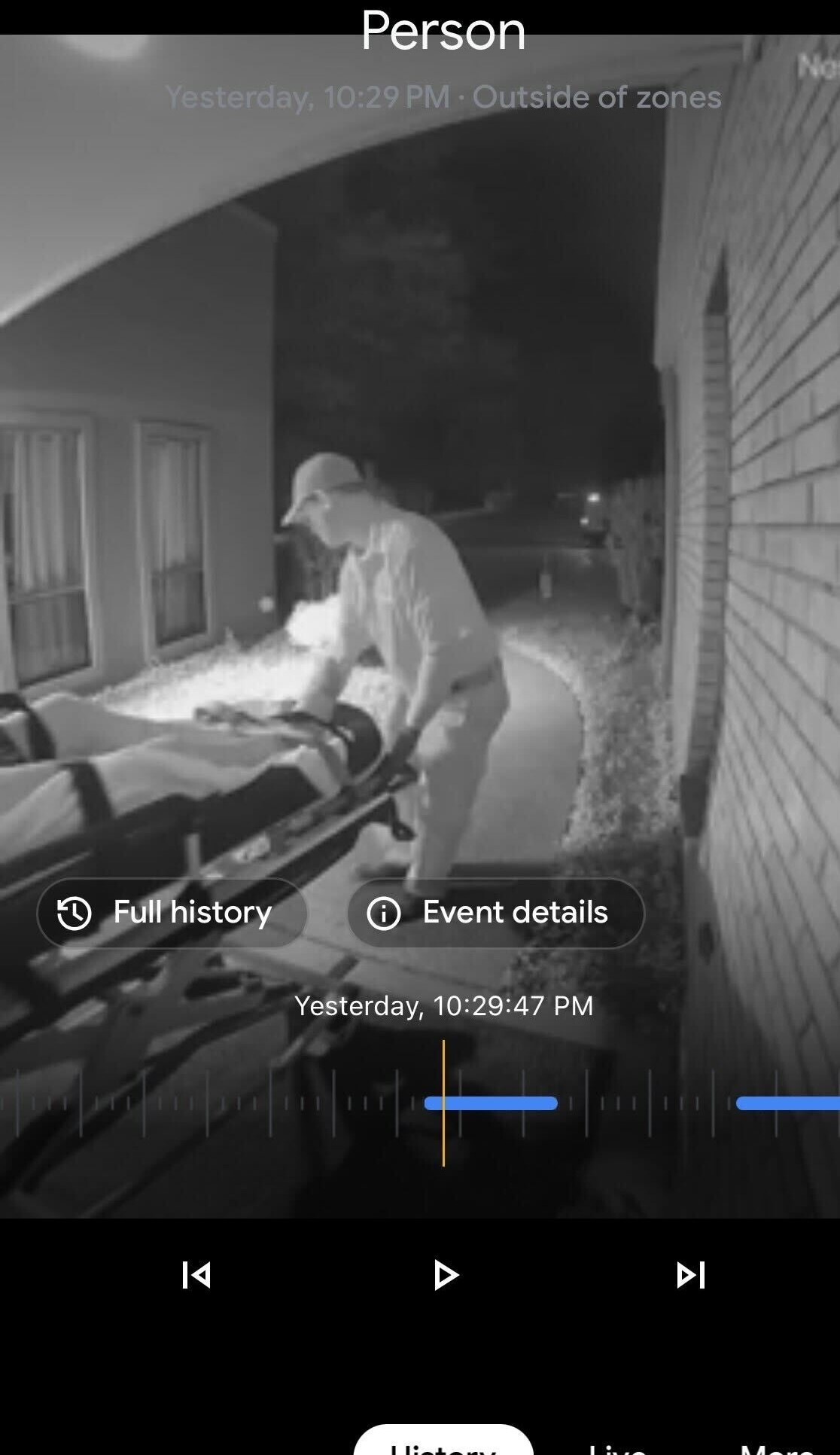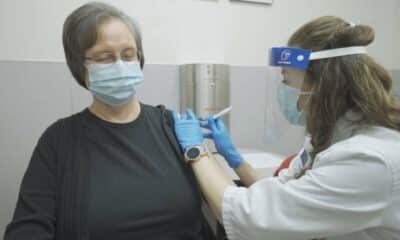Mississippi Today
‘It’s so much a death sentence’: Stroke victim waited 90 minutes for an ambulance in Jackson.

Donna Echols had just returned to her north Jackson home from her eldest son's fairytale wedding in the Bahamas and expected to greet the groom's father who had stayed behind to watch the house and her pets.
What she didn't expect was the start of an emotional rollercoaster.
That night, April 27, Echols found her ex-husband, “Diamond Jim” Mabus, on the living room floor unresponsive. Furniture was strewn around. She called 911 to ask for an ambulance.
What followed were five calls and an excruciating 90- minute wait before the county's ambulance provider, American Medical Response, arrived and took Mabus to St. Dominic Hospital.
Mabus was in the intensive care unit for a week until his death on May 4 at the age of 76. An MRI scan revealed he had suffered a series of small strokes and a large stroke. He left behind two sons from his marriage to Echols, two other sons, and friends and family.
“It angers me so much,” Echols said about AMR's drawn-out response time. “It's so much a death sentence for someone.”
AMR spokesperson Nicole Michel said the night Echols called, the central Mississippi service area was at a level zero, meaning there were no available ambulances. Eight ambulances and two sprint medics were already responding to other calls, and during the nine o'clock hour, AMR received six service requests, including one for a heart attack.
Triage protocols are applied to service calls to determine if people are suffering or are likely to suffer a life-threatening illness or injury, the spokesperson said.
Medical providers say that seconds count when someone suffers a stroke because brain cells immediately start to die. Response time can determine whether someone fully recovers, faces complications such as paralysis or dies.
Echols made the first 911 call at 9:15 p.m., according to cellphone records shared with Mississippi Today. Within 10 minutes, four Jackson firefighters arrived and started tending to Mabus, but they were not able to render further medical attention because they are not trained EMTs or paramedics, she said.
When the ambulance still hadn't arrived, firefighters at the scene called the ambulance provider themselves and were told Echols' address was in the queue but nobody had been dispatched yet, Echols said.
At one point, Echols called someone she knows who works at Pafford Ambulance, another private company contracted with Madison and Rankin counties, to see if they could send an ambulance. There was an ambulance bus five minutes away, but she was told she needed to get AMR to give permission to Pafford to respond and cross over into Hinds County – AMR's territory.
Echols called 911 again, and asked the AMR dispatcher what needed to be done to have Pafford respond instead. They told her there wasn't anything they could do about that.
Finally, at 10:25 p.m. the AMR ambulance arrived. Echols saved the home security image of first responders wheeling Mabus out the front door around 10:30 p.m.

In its contract with Hinds County, AMR is required to meet 85% of its Jackson and Clinton emergency calls in eight minutes or less and outer-Hinds County calls in 18 minutes or less, Mississippi Today reported in 2018 after analyzing the company's contract.
That year, there were over 32,000 emergency calls countywide. A review of calls by Mississippi Today and WLBT found the average trip time is an hour and a half. Time starts from when an ambulance is dispatched to when a hospital admits the patient.
Hinds EMS Coordinator Joey Jamison did not immediately respond to a request to receive a copy of or review the most recent AMR contract.
Echols' experience waiting for an ambulance came as providers across the state – including AMR – have shared fears that an ambulance system collapse is near.
A combination of staff shortages, low wages and an incomplete reimbursement system have been exacerbated by the ongoing COVID-19 pandemic, which has greatly affected Missisisppi's ambulence system, Mississippi Today reported.
In 2018, Mississippi Today reported that “wall time” – the time ambulances wait at a hospital for a bed to become available – often contributes to long response times. AMR agreed that hospital wait times are a challenge its first responders face.
“Every minute a crew is waiting for a bed is a minute the crew cannot respond to assist a patient outside of the hospital,” the company said in a statement.
Weeks since Mabus' death, Echols has more answers about that night, but she wonders whether AMR will make changes to ensure other families don't have to go through what hers did.
She understands that staff shortages have plagued multiple fields, including police and fire departments and hospitals, but she wants to know what the company is doing to fix that.
While efforts are taken to build up staff, Echols sees a mutual agreement or “helping hands” clause in AMR's contract as a potential solution to help when they are overwhelmed by a high volume of calls.
For example, such an agreement could have allowed a Pafford Ambulance to come to her home to tend to Mabus sooner, Echols said.
An AMR spokesperson said mutual aid agreements among ambulance providers in Mississippi tend to be in place for natural disasters or mass casualty events, but not for daily service requests.
Mutual aid can be requested, but the ambulance provider who receives it isn't required to respond because their service area takes precedence, the spokesperson said. Providers strongly prefer not to send crews outside the primary service area and often they don't have the resources to do so.
The spokesperson did not respond to questions asked about whether it is possible for another ambulance company to respond to a call in Hinds County and whether there is a process for someone to grant permission for an out-of-county ambulance to come to them.
“What I don't understand is why AMR has not pushed for mutual aid for a helping hands situation if they can't do the job,” Echols said. “It makes you ask the question: Are they more concerned about territory and profit than saving lives?”
“Is it my family today and your family tomorrow?”
This article first appeared on Mississippi Today and is republished here under a Creative Commons license.
Mississippi Today
Renada Stovall, chemist and entrepreneur
Renada Stovall sat on the back deck of her rural Arkansas home one evening, contemplating life when she had a life-altering epiphany…
“I gotta get out of these woods.”
She heard it as clear as lips to her ear and as deep as the trees surrounding her property. Stovall's job as a chemist had taken her all over the country. In addition to Arkansas, there were stints in Atlanta, Dallas and Reno. But she was missing home, her parents and friends. She also knew, she needed something else to do.
“I thought, what kind of business can I start for myself,” said Stovall, as she watered herbs growing in a garden behind her south Jackson home. Some of those herbs are used in her all-natural products. “I know when I lived in Reno, Nevada, where it's very hot and very dry, there really weren't products available that worked for me, my hair, and my skin suffered. I've got a chemistry degree from Spelman College. I took the plunge and decided to create products for myself.”

In 2018, Stovall's venture led to the creation of shea butter moisturizers and natural soaps. But she didn't stop there, and in December 2022, she moved home to Mississippi and got to work, expanding her product line to include body balms and butters, and shampoos infused with avocado and palm, mango butter, coconut and olive oils.
Nadabutter, which incorporates Renada's name, came to fruition.

Stovall sells her balms and moisturizers at what she calls, “pop-up markets,” across the state during the summer. She's available via social media and also creates products depending on what of her ingredients a customer chooses. “My turmeric and honey is really popular,” Stovall added.
“The all-natural ingredients I use are great for conditioning the skin and hair. All of my products make you feel soft and luscious. The shea butter I use comes from West Africa. It's my way of networking and supporting other women. And it's my wish that other women can be inspired to be self-sufficient in starting their own businesses.”





This article first appeared on Mississippi Today and is republished here under a Creative Commons license.
Mississippi Today
On this day in 1954
MAY 17, 1954

In Brown v. Board of Education and Bolling v. Sharpe, the U.S. Supreme Court unanimously ruled that the “separate but equal” doctrine in Plessy v. Ferguson was unconstitutional under the 14th Amendment, which guaranteed equal treatment under the law.
The historic decision brought an end to federal tolerance of racial segregation, ruling in the case of student Linda Brown, who was denied admission to her local elementary school in Topeka, Kansas, because of the color of her skin.
In Mississippi, segregationist leaders called the day “Black Monday” and took up the charge of the just-created white Citizens' Council to preserve racial segregation at all costs.
This article first appeared on Mississippi Today and is republished here under a Creative Commons license.
Mississippi Today
Every university but Delta State to increase tuition this year
Every university in Mississippi is increasing tuition in the fall except for Delta State University.
The new rates were approved by the governing board of the eight universities, the Institutions of Higher Learning Board of Trustees, at its regular meeting Thursday.
The average cost of tuition in Mississippi is now $8,833 a year, a roughly 3% increase from last year. Students can expect to pay tuition ranging from $7,942 a year at Mississippi Valley State University to $10,052 a year at Mississippi State University.
In recent years, universities have cited inflation and rising insurance costs as reasons for the tuition increases. At Thursday's meeting, the board heard a presentation on how property insurance is becoming more expensive for the eight universities as Mississippi sees more tornadoes and storms with severe wind and hail.
READ MORE: Tuition increases yet again at most public universities
But it's an ongoing trend. Mississippi's public universities have steadily increased tuition since 2000, putting the cost of college increasingly out of reach for the average Mississippi family. More than half of Mississippi college students graduated with an average of $29,714 in student debt in 2020, according to the Institution for College Access and Success.
At Delta State University, the president, Daniel Ennis, announced that he will attempt to avoid tuition increases as the regional college in the Mississippi Delta undergoes drastic budget cuts in an effort to become more financially sustainable.
“We will resist tuition increases so that our most economically vulnerable students can continue to have access to the opportunities that a college degree can provide,” he wrote in a memo to faculty and staff on Monday. “We will move beyond basic survival and into a place where we have the capacity to take better advantage of our undeniable strengths.”
Delta State didn't increase tuition last year, either. Officials have been concerned the university is becoming too pricey for the students it serves.
Tuition for the 2024-25 academic year, by school:
- Alcorn State University: $8,105
- Delta State University: $8,435
- Jackson State University: $8,690
- Mississippi State University: $10,052
- Mississippi University for Women: $8,392
- Mississippi Valley State University: $7,492
- University of Mississippi: $9,612
- University of Southern Mississippi: $9,888
This article first appeared on Mississippi Today and is republished here under a Creative Commons license.
-
SuperTalk FM5 days ago
Martin Lawrence making 3 stops in Mississippi on comedy tour
-
Our Mississippi Home4 days ago
Beat the Heat with Mississippi’s Best Waterparks
-
Our Mississippi Home5 days ago
Charlie’s U-Pik: Opening Soon for the Summer Season
-
Mississippi News Video7 days ago
Local dentists offer free dental care in Amory
-
SuperTalk FM20 hours ago
State auditor cracking down on Mississippians receiving unemployment benefits
-
Mississippi News Video3 days ago
Jackson has a gang problem
-
Kaiser Health News4 days ago
Medicaid ‘Unwinding’ Decried as Biased Against Disabled People
-
Mississippi Today7 days ago
On this day in 1968






































